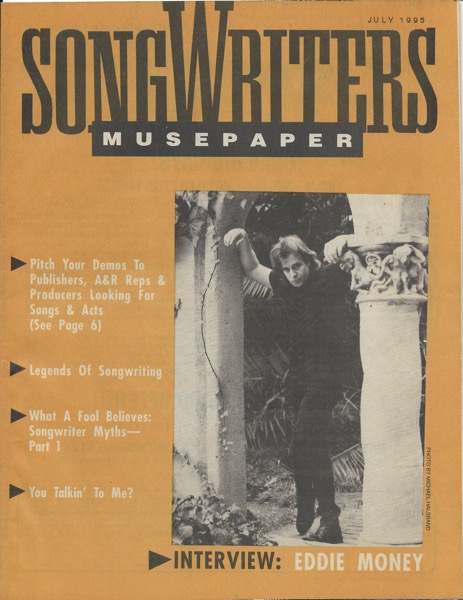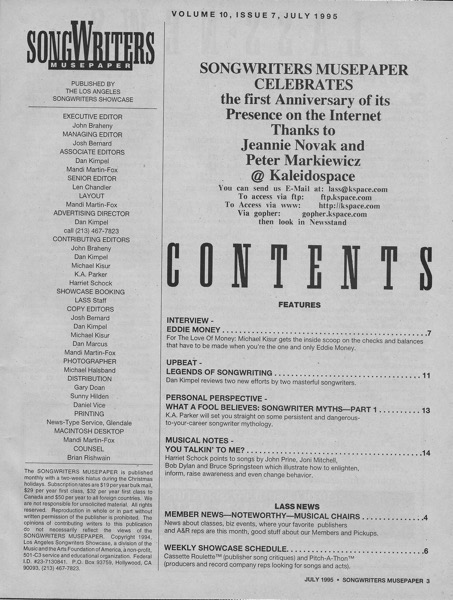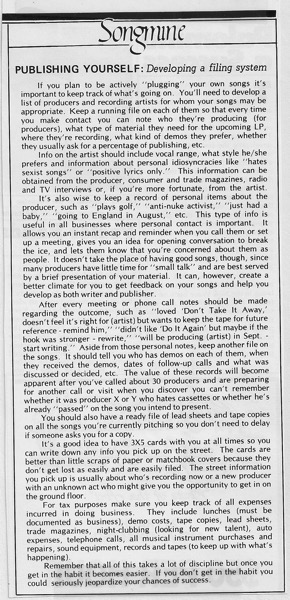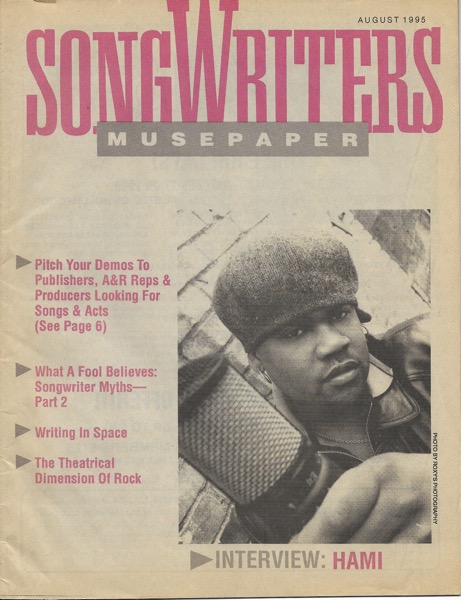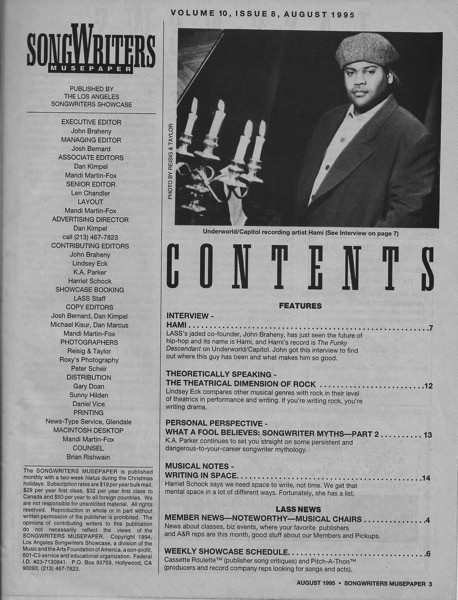A John Braheny Songmine column from the archives…
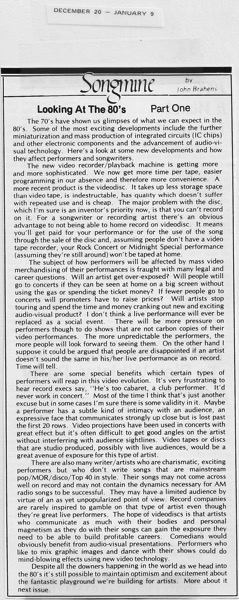
Accession Number: C000000137-026-001 Document/Digital File, “Publishing Yourself: Developing a Filing System”, OCR converted text under same Accession Number
(Digitally converted text. Some errors may occur)
DECEMBER 20 — JANUARY 9
Songmine by John Braheny
Looking At The 80’s Part One
The 70’s have shown us glimpses of what we can expect in the 80’s. Some of the most exciting developments include the further miniaturization and mass production of integrated circuits (IC chips) and other electronic components and the advancement of audio-vi-sual technology. Here’s a look at some new developments and how they affect performers and songwriters.
The new video recorder/playback machine is getting more and more sophisticated. We now get more time per tape, easier programming in our absence and therefore more convenience. A more recent product is the videodisc. It takes up less storage space than video tape, is indestructable, has quality which doesn’t suffer with repeated use and is cheap. The major problem with the disc, which I’m sure is an inventor’s priority now, is that you can’t record on it. For a songwriter or recording artist there’s an obvious advantage to not being able to home record on videodisc. It means you’ll get paid for your performance or for the use of the song through the sale of the disc and, assuming people don’t have a video tape recorder, your Rock Concert or Midnight Special performance (assuming they’re still around) won’t be taped at home.
The subject of how performers will be affected by mass video merchandising of their performances is fraught with many legal and career questions. Will an artist get over-exposed? Will people wtill go to concerts if they can be seen at home on a big screen without using the gas or spending the ticket money? If fewer people go to concerts will promoters have to raise prices? Will artists stop touring and spend the time and money cranking out new and exciting audio-visual product? I don’t think a live performance will ever be replaced as a social event. There will be more pressure on performers though to do shows that are not carbon copies of their video performances. The more unpredictable the performers, the more people will look forward to seeing them. On the other hand I suppose it could be argued that people are disappointed if an artist doesn’t sound the same in his/her live performance as on record. Time will tell.
There are some special benefits which certain types of performers will reap in this video evolution. It’s very frustrating to hear record execs say, “He’s too cabaret, a club performer. It’d never work in concert.” Most of the time I think that’s just another excuse but in some cases I’m sure there is some validity in it. Maybe a performer has a subtle kind of intimacy with an audience, an expressive face that communicates strongly up close but is lost past the first 20 rows. Video projections have been used in concerts with great effect but it’s often difficult to get good angles on the artist without interferring with audience sightlines. Video tapes or discs that are studio produced, possibly with live audiences, would be a great avenue of exposure for this type of artist.
There are also many writer/artists who are charismatic, exciting performers but who don’t write songs that are mainstream pop/MOR/disco/Top 40 in style. Their songs may not come across well on record and may not contain the dynamics necessary for AM radio songs to be successful. They may have a limited audience by virtue of an as yet unpopularized point of view. Record companies are rarely inspired to gamble on that type of artist even though they’re great live performers. The hope of videodiscs is that artists who communicate as much with their bodies and personal magnetism as they do with their songs can gain the exposure they need to be able to build profitable careers. Comedians would obviously benefit from audio-visual presentations. Performers who like to mix graphic images and dance with their shows could do mind-blowing effects using new video technology.
Despite all the downers happening in the world as we head into the 80’s it’s still possible to maintain optimism and excitement about the fantastic playground we’re building for artists. More about it next issue.
Previously in the Songmine Collection:
- Songmine: Publishing Yourself: Developing a Filing System by John Braheny
- Songmine: Administration Deals & Starting Your Own Company by John Braheny
- Songmine: Tough Enough To Publish Yourself? by John Braheny
- Songmine: The Nashville/LA Barrier Crumbles by John Braheny
- Songmine: Message Songs Part 2 by John Braheny
- Songmine: Message Songs Part 1 by John Braheny
- Songmine: Rhyme by John Braheny
- Songmine: “The Knack” A 3rd Point of View by John Braheny
- Songmine: For the non-writing artist: Where do you find original material? by John Braheny
- Songmine: For the non-writing artist: Why you need original material by John Braheny
- Songmine: Scoring Films on a Low Budget Part 6 by John Braheny
- Scoring Films on a Low Budget Part 5 by John Braheny
- Songmine: Scoring Films on a Low Budget Part 4 by John Braheny
- Songmine: Scoring Films on a Low Budget Part 3 by John Braheny
- Songmine: Scoring Films on a Low Budget Part 2: Research and Spotting
- Songmine: Scoring Films on a Low Budget Part 1
- Songmine: The Chances for Advances by John Braheny
- Songmine: What a Record Company Needs to Know – Part 6: Attorneys by John Braheny
- Songmine: What a Record Company Needs to Know – Part 5: The Professional Team by John Braheny
- Songmine: What a Record Company Needs to Know – Part 4: What Makes This Act Marketable? by John Braheny
- Songmine: What A Record Company Needs to Know : Part 3
- Songmine: What A Record Company Needs to Know: Part 2 by John Braheny
- Songmine: What A Record Company Needs to Know: Part 1 by John Braheny
- Songmine: Getting the Most from the Trades Part 4
- Songmine: Getting the Most from the Trades Part 3 by John Braheny
- Getting the Most from the Trades
- Songmine: Publishing III
- Songmine: Leave Your Ego at the Door
- Songmine: “Feedback: Why some publishers won’t give it”
- Songmine: Dealing with Rejection by John Braheny
- “Music in Print” – A Songmine Column from Music Connection Magazine March 19-April 1, 1981
About Songmine and Music Connection Magazine:
John Braheny met Eric Bettelli and Michael Dolan right before they were going to publish Music Connection magazine. Eric and Michael wanted to get their publication out to as many songwriters as they could. They had already heard of the LA Songwriters Showcase, and of John and his partner, Len Chandler. John’s goal was to advertise the schedule of guest speakers and performers at the weekly Showcase… so they made a deal.
They published John’s Songmine column (he had never before written a magazine article!) in their very first edition, in November 1977. Trading out the column for advertising, this arrangement continued for many years. Plus, Eric and Michael came to the Showcase each week and distributed free copies to the songwriters!
Those articles became so popular that (book agent and editor) Ronny Schiff offered John’s articles to F&W Media, where they became the backbone of John’s textbook, The Craft and Business of Songwriting. As a follow-up, Dan Kimpel (author, songwriter, teacher), who had also worked at LASS, took on the Songwriting column at Music Connection magazine which continues to this day! You can subscribe to get either hard copies or online.
